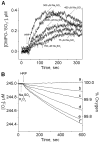The fidelity of spin trapping with DMPO in biological systems
- PMID: 21246623
- PMCID: PMC3090771
- DOI: 10.1002/mrc.2709
The fidelity of spin trapping with DMPO in biological systems
Abstract
Unlike direct ESR, spin trap methodology depends on the absolute fidelity of the spin trap reaction. Two alternative reactions of 5,5-dimethyl-1-pyrroline N-oxide (DMPO) leading to radical adduct artifacts have been discovered and investigated: inverted spin trapping and the Forrester-Hepburn nucleophilic mechanism. These two alternate pathways to radical adducts are a combination of one-electron oxidation and nucleophilic addition, in either order. In biological systems, serious artifacts have been reported due to the Forrester-Hepburn mechanism, which is initiated by the addition of a nucleophile to DMPO. It has recently been demonstrated that (bi)sulfite (hydrated sulfur dioxide) can react with DMPO via a nonradical, nucleophilic reaction, and it has been further proposed that DMPO/(•)SO(3)(-) formation in biological systems is an artifact and not the result of spin trapping of sulfur trioxide anion radical ((•)SO(3)(-)). The one-electron oxidation of (bi)sulfite catalyzed by horseradish peroxidase (HRP)/hydrogen peroxide (H(2)O(2)) has been reinvestigated by ESR spin trapping with DMPO and oxygen uptake studies to obtain further evidence for the radical reaction mechanism. In the absence of DMPO, the initial rate of (bi)sulfite-dependent oxygen and H(2)O(2) consumption was determined to be half of the initial rate of DMPO/(•)SO(3)(-) radical adduct formation as determined by ESR, demonstrating that, under our experimental conditions, DMPO exclusively forms the radical adduct by trapping the (•)SO(3)(-).
Copyright © 2011 John Wiley & Sons, Ltd.
Figures








References
-
- Beauchamp C, Fridovich I. Anal Biochem. 1971;44:276. - PubMed
-
- McCord JM, Fridovich I. J Biol Chem. 1968;243:5753. - PubMed
-
- Janzen EG, Haire DL. Adv Free Radic Chem. 1990;1:253.
-
- Knecht KT, Mason RP. Arch Biochem Biophys. 1993;303:185. - PubMed
-
- Davies MJ, Hawkins CL. Free Radic Biol Med. 2004;36:1072. - PubMed
Publication types
MeSH terms
Substances
Grants and funding
LinkOut - more resources
Full Text Sources
Miscellaneous

